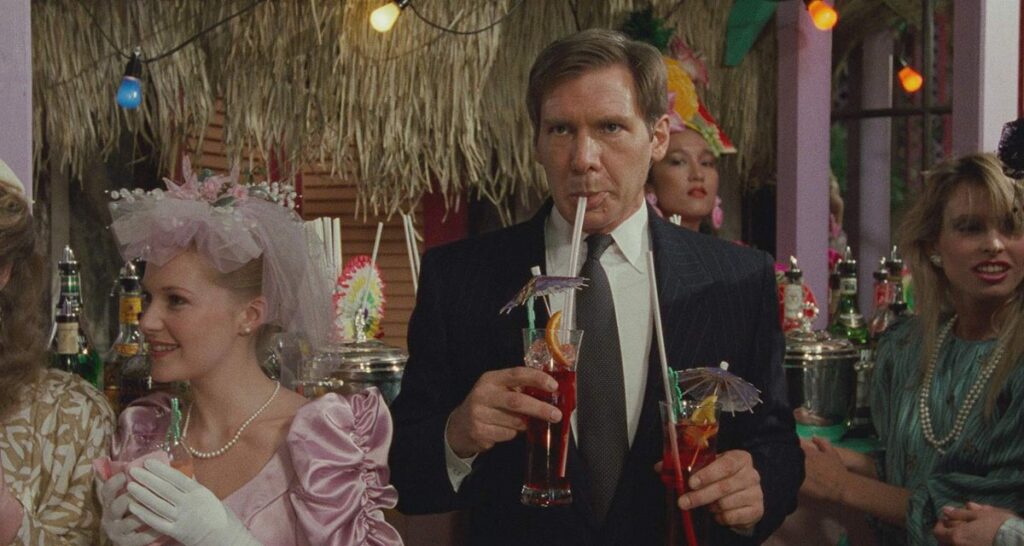Happy Labor Day!

Mike Nichols’ romantic comedy Working Girl (1988) re-imagines the Preston Sturges comedies of the forties for the late eighties; trading in Depression era fantasies of the American Dream for Reagan era values of gumption, duplicity, and corporate prestige. Working Girl is as funny and charming as it is dated. It is a film tied to the styles, politics, and social cues of its day to such an extent that the allusions to Sturges’ comedies are often diluted. Yet, Working Girl was Mike Nichols best film since The Fortune (1975) and a clear return to cultural relevancy.
Working Girl was penned by Mark Rappaport’s frequent collaborator Kevin Wade who would go on to more mainstream success in Hollywood with projects like Junior (1994) and Maid In Manhattan (2002). At the time, Working Girl was Wade’s first real foray into the world of big budget studio productions. His script draws on all of the archetypal characters of Preston Sturges’ The Great McGinty (1940) and Easy Living (1937) to flesh out a contemporary world of acquisitions and mergers. Melanie Griffith’s Tess McGill is an obvious descendent of Jean Arthur’s Mary Smith while Harrison Ford takes the part that so often went to actors such as Dick Powell, Ray Milland, and Brian Donlevy. Wade effectively proves that Sturges’ formula still works, bringing wit, aplomb, and plenty of charm back to the romantic comedy.
It’s no surprise that Sigourney Weaver should excel as a villain or that Philip Bosco would be so convincing in the Edward Arnold role. It was, however, at the time and to some viewers today surprising that Harrison Ford would be so affable and quirky in the romantic lead. Ford rises to the occasion to create a character that is completely charming, galant, and likable from the very second that he comes into frame. Ford brings out the best in Melanie Griffith just as she brings out the goofball in him. Together they shine while apart it is Griffith who more than carries the film.
All the romance, humor, and general silliness that Wade and Nichols imbue Working Girl with are not the whole of its parts. Beneath all of the fun, romantic comedy trappings Working Girl is, as the title suggests, a discreet critique of the kinds of roles women are allowed to play in the world of high finance. Hopefully things have changed, but at the time women were almost always only assistants. These women were, as demonstrated in the scene with Kevin Spacey, often abused and/or exploited. Weaver’s character exemplifies the one type of woman that was believed to be capable of rising in the ranks of men and she is cast as the bad guy, the anti-Griffith. That Griffith succeeds is treated as a stroke of exceptionalism that keeps in line with the concepts of the American Dream as Preston Sturges knew it.
The social critiques in Working Girl occur on a one to one basis outside of a larger group or collective of female assistants. Neither Nichols nor Wade allows any serious camaraderie between women beyond the friendship between the Griffith and Joan Cusack characters. The commentaries on interoffice relationships in Working Girl are rendered merely as gestures; a secondary concern after the primary focus on the romance between Ford and Griffith. In its day, Working Girl was seen as progressive or even feminist but only insofar as Nichols and Wade were capable of.
Of course these shortcomings do not detract from the pleasures of the film itself. Working Girl is a great comedy and one of Mike Nichols best and most undervalued pictures. For the scene where a room full of secretaries ogle a shirtless Harrison Ford and applaud his physic Working Girl deserves to be ranked as a bonafide classic. Personally, I’d rank Working Girl right alongside Moonstruck (1987) as the best romantic comedy of the eighties.
